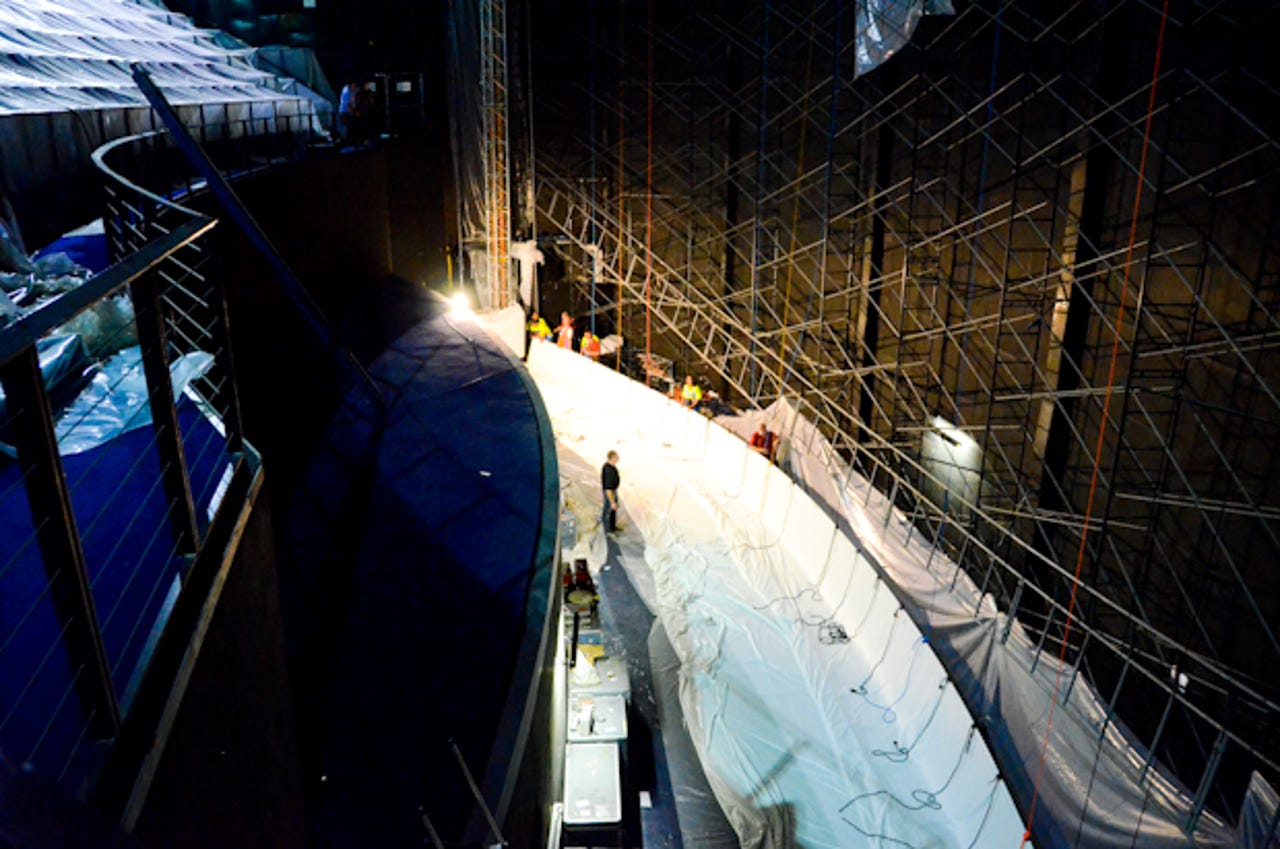IMAX replaces world's largest screen: pics


(Credit: Chuong Vu/ZDNet Australia)
Riggers work in the pit of the IMAX theatre to rig the 800-kilogram screen for its hoisting high above the floor.
(Credit: IMAX Theatre Sydney)
The screen is made from a material that was described as "not dissimilar from the vinyl material used for ute covers". It took 31 riggers to get it from the floor to the ceiling.
IMAX Australia told ZDNet Australia that the screen is being replaced due to the fact that the old screen was at the end of its life. The new screen is designed to reflect brighter images. By doing so, the 3D experience — which is made dimmer by watchers wearing glasses — will improve.
(Credit: IMAX Theatre Sydney)
The material the screen is made from has billions of tiny holes in it so that the five speakers mounted behind it can project the booming sound through.
(Credit: IMAX Theatre Sydney)
The hoisting begins. Once the screen is fixed to the rigging, it will be painted with 350 kilograms of high-gain, silver gloss paint.
The paint rig is a large piece of scaffolding put together inside the theatre. Attached to it is a carriage that will move along a track on the floor to paint up and down the screen over the next four days.
(Credit: IMAX Theatre Sydney)
A marshal standing on the second level of the theatre bellows orders to the rigging crew to pull up the screen to the top of the theatre.
(Credit: IMAX Theatre Sydney)
After half an hour, the screen is secure, where it will stay for the next decade.
(Credit: Luke Hopewell/ZDNet Australia)
Mark Bretherton, CEO at IMAX Theatre Sydney, stands by the theatre's $1.6 million film projector. Bretherton told ZDNet Australia that the screen replacement project has been in the making for 12 months and will cost $250,000.
He added that the theatre is unlikely to see a new, digital projector installed in the next 12 months, as the film is still far superior to digital projection in an IMAX setting.
"Digital is clearly something that's going to happen in the future, but it's not something we're going to do in the next 12 months by any means. Currently, the quality and the resolution of the 15/70 [millimetre] film we show, far surpasses anything in digital. In terms of resolution [and] picture clarity, 15/70mm IMAX film is still the best for high-quality resolution," Bretherton said.
Another problem with digital projectors is the low brightness of the projected image and the heat produced by the projector itself. Bretherton said that IMAX is currently working on a projector that uses lasers to project light, rather than the xenon bulbs used in current systems.
"It all comes back to the right amount of light ... and not generating too much heat. The current xenon lamps would fry the chips in the digital projector, and that's not something we want in a commercial proposition," he said.
(Credit: Luke Hopewell/ZDNet Australia)
A small forklift is required to lift each roll of the 15/70mm IMAX film into place. Two rolls of film are required to project a 3D IMAX image, one each for the left and right eyes.
(Credit: Luke Hopewell/ZDNet Australia)
The $1.6 million film projector is linked directly into the air-conditioning ducts in the projection booth to ensure that the unit doesn't overheat during use.
(Credit: IMAX Theatre Sydney)
The rigging team that lifted the 800-kilogram screen.
Updated at 8:43am, 13 February 2012: corrected an issue in several captions that incorrectly referred to IMAX film size as 1570-millimetre film. It is in fact 15/70-millimetre.